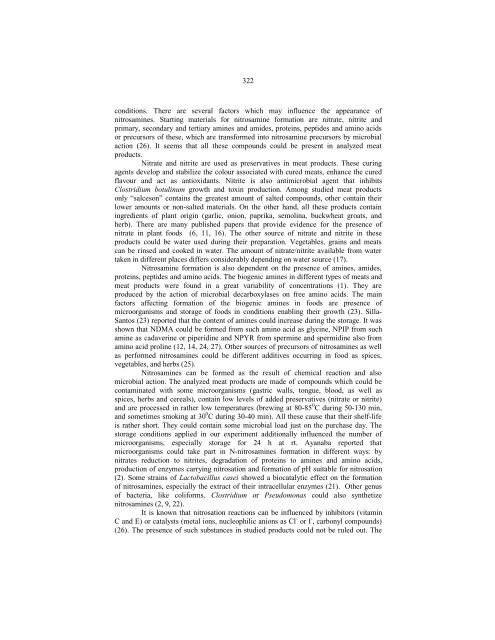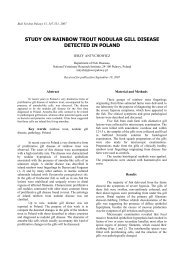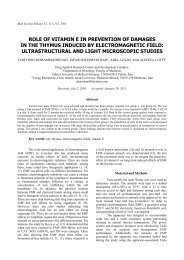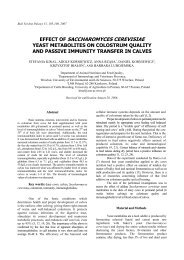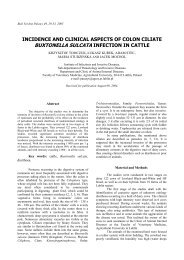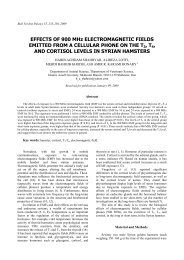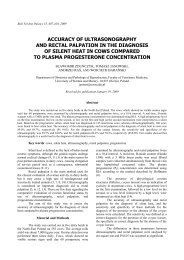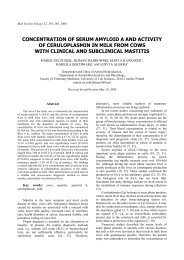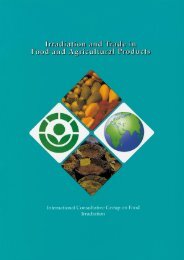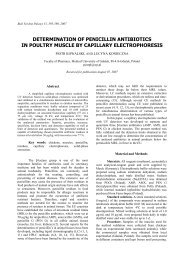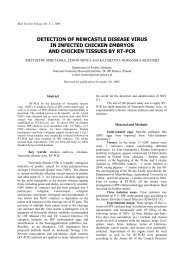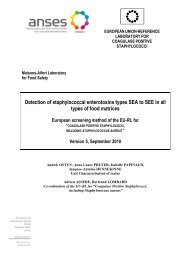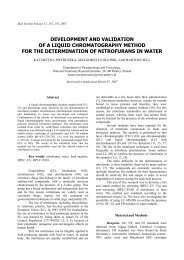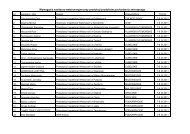effect of different storage conditions on n-nitrosamine content in ...
effect of different storage conditions on n-nitrosamine content in ...
effect of different storage conditions on n-nitrosamine content in ...
You also want an ePaper? Increase the reach of your titles
YUMPU automatically turns print PDFs into web optimized ePapers that Google loves.
322<str<strong>on</strong>g>c<strong>on</strong>diti<strong>on</strong>s</str<strong>on</strong>g>. There are several factors which may <strong>in</strong>fluence the appearance <str<strong>on</strong>g>of</str<strong>on</strong>g><strong>nitrosam<strong>in</strong>e</strong>s. Start<strong>in</strong>g materials for <strong>nitrosam<strong>in</strong>e</strong> formati<strong>on</strong> are nitrate, nitrite andprimary, sec<strong>on</strong>dary and tertiary am<strong>in</strong>es and amides, prote<strong>in</strong>s, peptides and am<strong>in</strong>o acidsor precursors <str<strong>on</strong>g>of</str<strong>on</strong>g> these, which are transformed <strong>in</strong>to <strong>nitrosam<strong>in</strong>e</strong> precursors by microbialacti<strong>on</strong> (26). It seems that all these compounds could be present <strong>in</strong> analyzed meatproducts.Nitrate and nitrite are used as preservatives <strong>in</strong> meat products. These cur<strong>in</strong>gagents develop and stabilize the colour associated with cured meats, enhance the curedflavour and act as antioxidants. Nitrite is also antimicrobial agent that <strong>in</strong>hibitsClostridium botul<strong>in</strong>um growth and tox<strong>in</strong> producti<strong>on</strong>. Am<strong>on</strong>g studied meat products<strong>on</strong>ly “salces<strong>on</strong>” c<strong>on</strong>ta<strong>in</strong>s the greatest amount <str<strong>on</strong>g>of</str<strong>on</strong>g> salted compounds, other c<strong>on</strong>ta<strong>in</strong> theirlower amounts or n<strong>on</strong>-salted materials. On the other hand, all these products c<strong>on</strong>ta<strong>in</strong><strong>in</strong>gredients <str<strong>on</strong>g>of</str<strong>on</strong>g> plant orig<strong>in</strong> (garlic, <strong>on</strong>i<strong>on</strong>, paprika, semol<strong>in</strong>a, buckwheat groats, andherb). There are many published papers that provide evidence for the presence <str<strong>on</strong>g>of</str<strong>on</strong>g>nitrate <strong>in</strong> plant foods (6, 11, 16). The other source <str<strong>on</strong>g>of</str<strong>on</strong>g> nitrate and nitrite <strong>in</strong> theseproducts could be water used dur<strong>in</strong>g their preparati<strong>on</strong>. Vegetables, gra<strong>in</strong>s and meatscan be r<strong>in</strong>sed and cooked <strong>in</strong> water. The amount <str<strong>on</strong>g>of</str<strong>on</strong>g> nitrate/nitrite available from watertaken <strong>in</strong> <str<strong>on</strong>g>different</str<strong>on</strong>g> places differs c<strong>on</strong>siderably depend<strong>in</strong>g <strong>on</strong> water source (17).Nitrosam<strong>in</strong>e formati<strong>on</strong> is also dependent <strong>on</strong> the presence <str<strong>on</strong>g>of</str<strong>on</strong>g> am<strong>in</strong>es, amides,prote<strong>in</strong>s, peptides and am<strong>in</strong>o acids. The biogenic am<strong>in</strong>es <strong>in</strong> <str<strong>on</strong>g>different</str<strong>on</strong>g> types <str<strong>on</strong>g>of</str<strong>on</strong>g> meats andmeat products were found <strong>in</strong> a great variability <str<strong>on</strong>g>of</str<strong>on</strong>g> c<strong>on</strong>centrati<strong>on</strong>s (1). They areproduced by the acti<strong>on</strong> <str<strong>on</strong>g>of</str<strong>on</strong>g> microbial decarboxylases <strong>on</strong> free am<strong>in</strong>o acids. The ma<strong>in</strong>factors affect<strong>in</strong>g formati<strong>on</strong> <str<strong>on</strong>g>of</str<strong>on</strong>g> the biogenic am<strong>in</strong>es <strong>in</strong> foods are presence <str<strong>on</strong>g>of</str<strong>on</strong>g>microorganisms and <str<strong>on</strong>g>storage</str<strong>on</strong>g> <str<strong>on</strong>g>of</str<strong>on</strong>g> foods <strong>in</strong> <str<strong>on</strong>g>c<strong>on</strong>diti<strong>on</strong>s</str<strong>on</strong>g> enabl<strong>in</strong>g their growth (23). Silla-Santos (23) reported that the c<strong>on</strong>tent <str<strong>on</strong>g>of</str<strong>on</strong>g> am<strong>in</strong>es could <strong>in</strong>crease dur<strong>in</strong>g the <str<strong>on</strong>g>storage</str<strong>on</strong>g>. It wasshown that NDMA could be formed from such am<strong>in</strong>o acid as glyc<strong>in</strong>e, NPIP from sucham<strong>in</strong>e as cadaver<strong>in</strong>e or piperid<strong>in</strong>e and NPYR from sperm<strong>in</strong>e and spermid<strong>in</strong>e also fromam<strong>in</strong>o acid prol<strong>in</strong>e (12, 14, 24, 27). Other sources <str<strong>on</strong>g>of</str<strong>on</strong>g> precursors <str<strong>on</strong>g>of</str<strong>on</strong>g> <strong>nitrosam<strong>in</strong>e</strong>s as wellas performed <strong>nitrosam<strong>in</strong>e</strong>s could be <str<strong>on</strong>g>different</str<strong>on</strong>g> additives occurr<strong>in</strong>g <strong>in</strong> food as spices,vegetables, and herbs (25).Nitrosam<strong>in</strong>es can be formed as the result <str<strong>on</strong>g>of</str<strong>on</strong>g> chemical reacti<strong>on</strong> and alsomicrobial acti<strong>on</strong>. The analyzed meat products are made <str<strong>on</strong>g>of</str<strong>on</strong>g> compounds which could bec<strong>on</strong>tam<strong>in</strong>ated with some microorganisms (gastric walls, t<strong>on</strong>gue, blood, as well asspices, herbs and cereals), c<strong>on</strong>ta<strong>in</strong> low levels <str<strong>on</strong>g>of</str<strong>on</strong>g> added preservatives (nitrate or nitrite)and are processed <strong>in</strong> rather low temperatures (brew<strong>in</strong>g at 80-85 0 C dur<strong>in</strong>g 50-130 m<strong>in</strong>,and sometimes smok<strong>in</strong>g at 30 0 C dur<strong>in</strong>g 30-40 m<strong>in</strong>). All these cause that their shelf-lifeis rather short. They could c<strong>on</strong>ta<strong>in</strong> some microbial load just <strong>on</strong> the purchase day. The<str<strong>on</strong>g>storage</str<strong>on</strong>g> <str<strong>on</strong>g>c<strong>on</strong>diti<strong>on</strong>s</str<strong>on</strong>g> applied <strong>in</strong> our experiment additi<strong>on</strong>ally <strong>in</strong>fluenced the number <str<strong>on</strong>g>of</str<strong>on</strong>g>microorganisms, especially <str<strong>on</strong>g>storage</str<strong>on</strong>g> for 24 h at rt. Ayanaba reported thatmicroorganisms could take part <strong>in</strong> N-<strong>nitrosam<strong>in</strong>e</strong>s formati<strong>on</strong> <strong>in</strong> <str<strong>on</strong>g>different</str<strong>on</strong>g> ways: bynitrates reducti<strong>on</strong> to nitrites, degradati<strong>on</strong> <str<strong>on</strong>g>of</str<strong>on</strong>g> prote<strong>in</strong>s to am<strong>in</strong>es and am<strong>in</strong>o acids,producti<strong>on</strong> <str<strong>on</strong>g>of</str<strong>on</strong>g> enzymes carry<strong>in</strong>g nitrosati<strong>on</strong> and formati<strong>on</strong> <str<strong>on</strong>g>of</str<strong>on</strong>g> pH suitable for nitrosati<strong>on</strong>(2). Some stra<strong>in</strong>s <str<strong>on</strong>g>of</str<strong>on</strong>g> Lactobacillus casei showed a biocatalytic <str<strong>on</strong>g>effect</str<strong>on</strong>g> <strong>on</strong> the formati<strong>on</strong><str<strong>on</strong>g>of</str<strong>on</strong>g> <strong>nitrosam<strong>in</strong>e</strong>s, especially the extract <str<strong>on</strong>g>of</str<strong>on</strong>g> their <strong>in</strong>tracellular enzymes (21). Other genus<str<strong>on</strong>g>of</str<strong>on</strong>g> bacteria, like coliforms, Clostridium or Pseudom<strong>on</strong>as could also synthetize<strong>nitrosam<strong>in</strong>e</strong>s (2, 9, 22).It is known that nitrosati<strong>on</strong> reacti<strong>on</strong>s can be <strong>in</strong>fluenced by <strong>in</strong>hibitors (vitam<strong>in</strong>C and E) or catalysts (metal i<strong>on</strong>s, nucleophilic ani<strong>on</strong>s as Cl - or I - , carb<strong>on</strong>yl compounds)(26). The presence <str<strong>on</strong>g>of</str<strong>on</strong>g> such substances <strong>in</strong> studied products could not be ruled out. The


